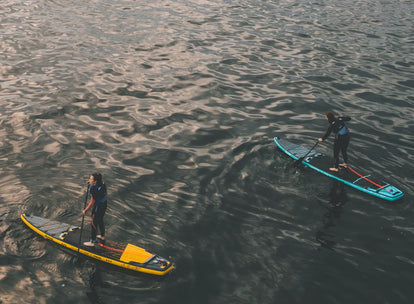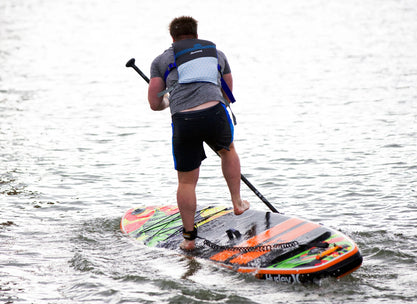Paddle Boarding has become a popular water sport in recent years, and with the thousands of new enthusiasts out on the water, you may have noticed us and other companies placing an emphasis on safety equipment. Even if you don’t have time to read a whole blog about floating gourds and what a PFD is (We’ll get to that later…) we’ll leave you with this one main message: Wear your buoyancy aid!
If you can spare 5 minutes, you never know, finding out why a QR belt is actually useful could save a life.
Why a Buoyancy Aid?

Buoyancy aids or PFD’s (personal floatation device) have come an awfully long way throughout history. There are examples from as early as 870 AD of people using inflated animal skins or hollowed out gourds to assist them in swimming. From there we advanced to using vests made of wood and cork, eventually progressing to our modern materials that are both super lightweight and compact, allowing you complete freedom of movement while still getting the job done!
One of the most significant risks associated with paddleboarding is falling into the water. Even experienced paddleboarders can fall off their boards due to strong winds, choppy conditions, or losing their balance. When this happens, wearing a buoyancy aid can help keep you afloat and prevent you from drowning. It is important to note that a buoyancy aid is not the same as a life jacket, which is designed to turn an unconscious person face up in the water.
The way that we have designed our buoyancy aids means that there is no restriction on your arm or turning movement, which in turn means that although at first sight it might look cumbersome to be wearing one, they are not constraining at all, and well worth the peace of mind! Designed to fit snugly around your chest and torso, a properly fitted PFD will stay in place while you move. Make sure that the buoyancy aid is properly fitted and adjusted to your body size to ensure maximum effectiveness.
Leash

Let's start with some quick leash basics. A leash attaches you to your paddleboard, ensuring that you do not drift too far away from it if you fall off. It is designed to attach your paddleboard to your ankle or calf, ensuring that you stay connected to your board at all times. This is of primary importance when in strong currents or choppy or rough waters, where with a moment’s distraction you could be in the drink and your board whisked away to cause havoc in the beach’s swimming only section. With this simple piece of kit you can pull the board back towards you and be back to paddling in minutes.

So, in what circumstances would your ankle leash potentially not be appropriate?
If you’re a river paddler, you may well have seen other paddle boarders out with their leash attached to their waist. This is called a QR (Quick Release) safety belt. It’s very simply a belt with a toggle at the front, which is used in conjunction with your existing leash. It is easy to access and allows you to “quickly release” the belt in case of an emergency. This might be essential if your board becomes stuck upstream, and you’re left tethered to it being pulled in the opposite direction, unable to reach your ankle leash and taking on water. When paddling in stronger currents or faster moving water we would always recommend wearing a quick release belt, and they are often found useful even in still water as ankle leashes can get tangled up in or tripped over far more easily.
Other Gear

In addition to wearing a buoyancy aid, there are other safety equipment items you should consider wearing while paddleboarding, such as a helmet.
Although wearing a helmet is not mandatory while paddleboarding, it is highly recommended if you are paddling in areas with potential hazards such as rocks, reefs, or other obstacles, or are experimenting with the more extreme whitewater paddling. Make sure that your helmet is designed for water sports, as not all helmets are suitable.
Other Safety Equipment: In addition to the three items mentioned above, there are other safety equipment items you can wear while paddleboarding, such as a wetsuit, rash guard, or water shoes. These items help protect your body from the elements, reduce the risk of injury, and improve your overall comfort while paddleboarding.
Conclusion

These points just represent the tip of the iceberg, and there is always more to learn about safety, but wearing your buoyancy aid and leash is the absolute best place to begin. Remember to put safety first and where appropriate share the knowledge of SUP safety with your paddle community. Now, grab your board and get back on the water!
Stay Safe & Happy Paddling!


